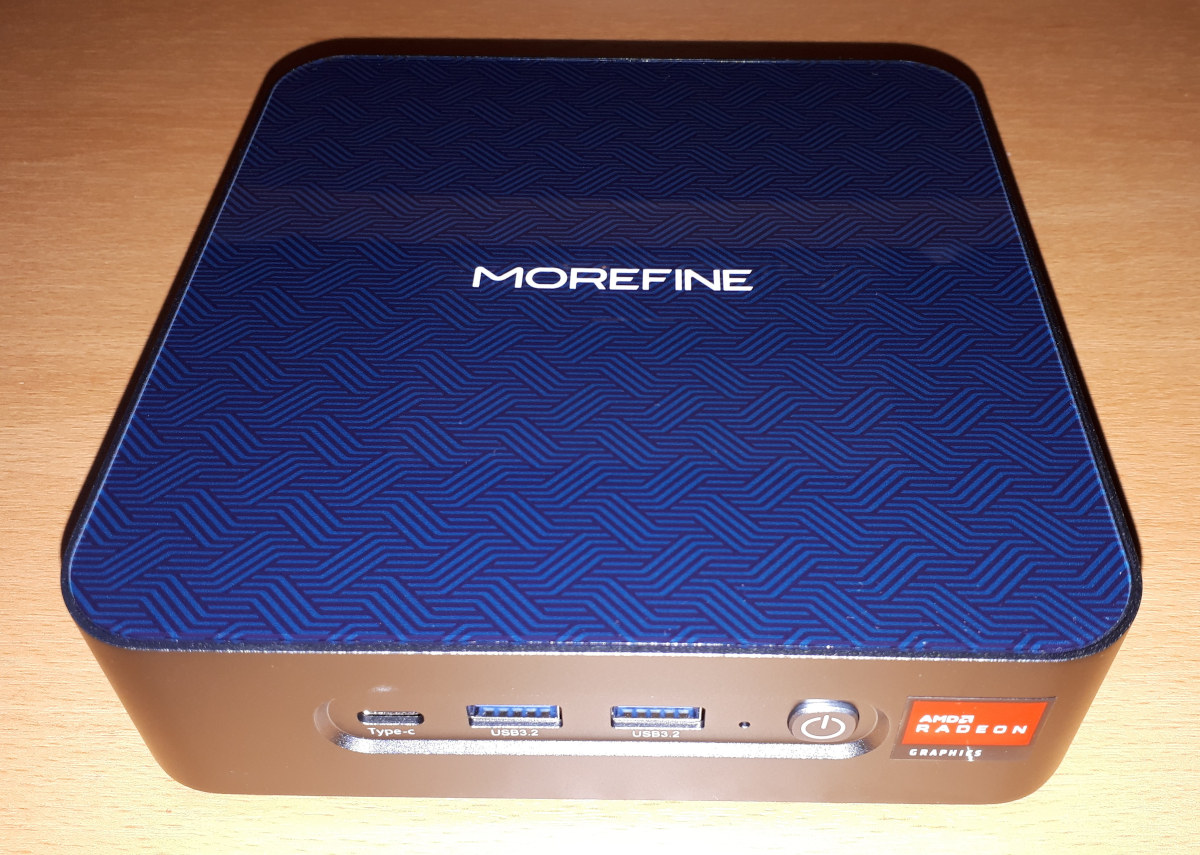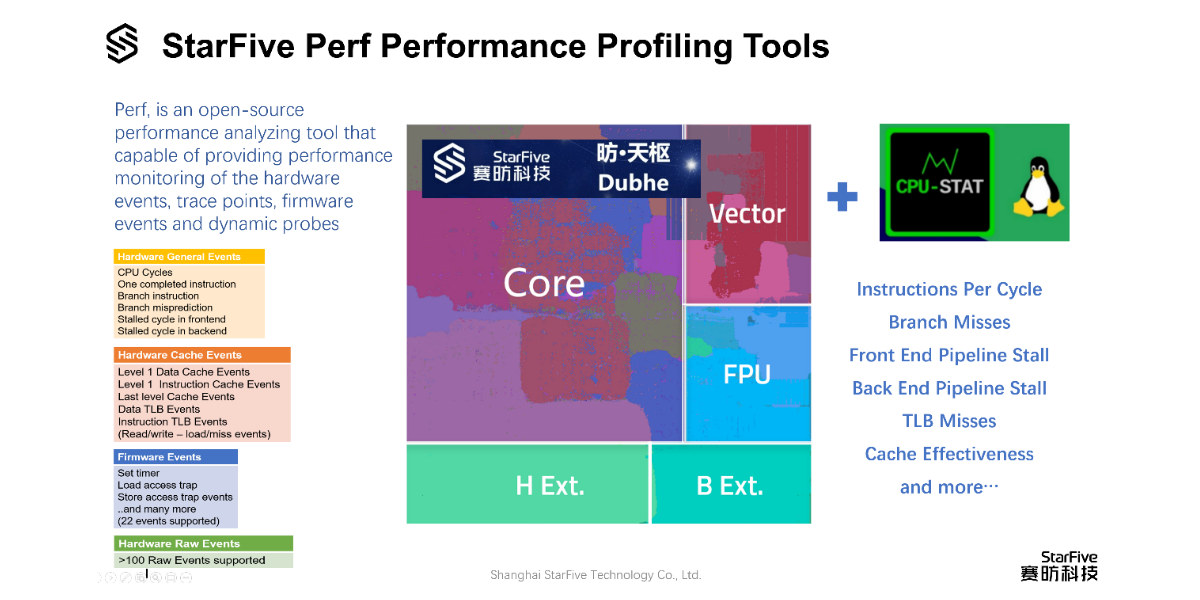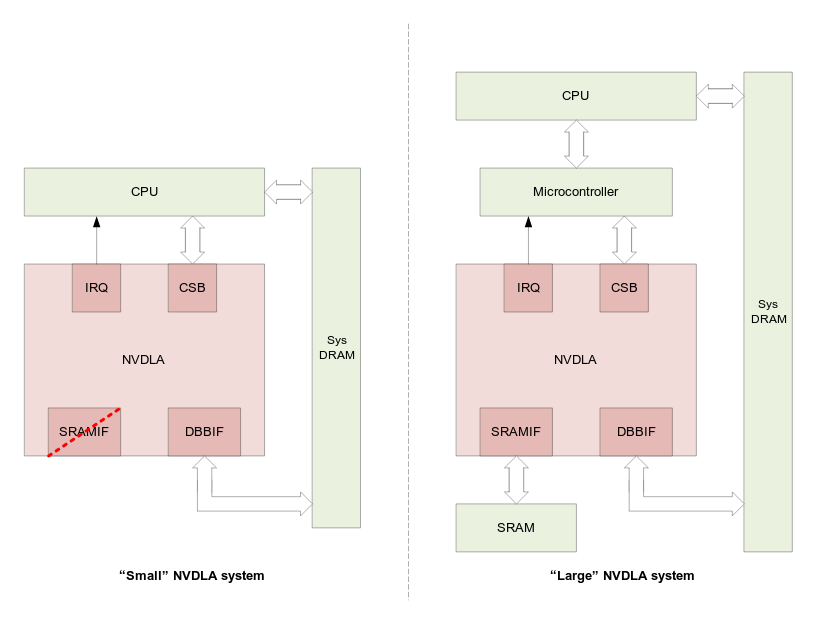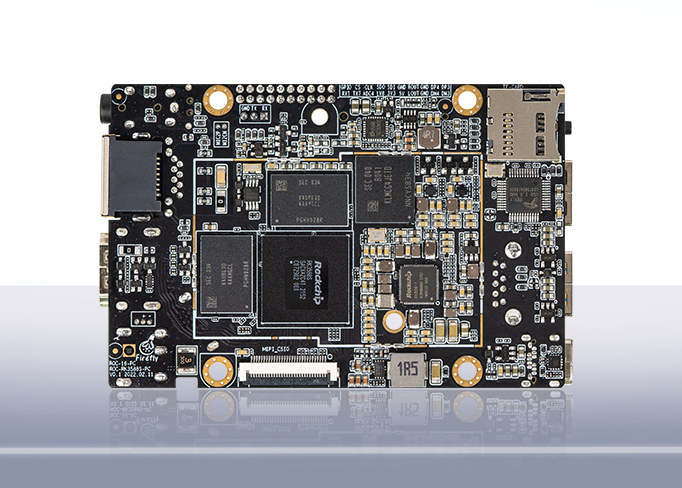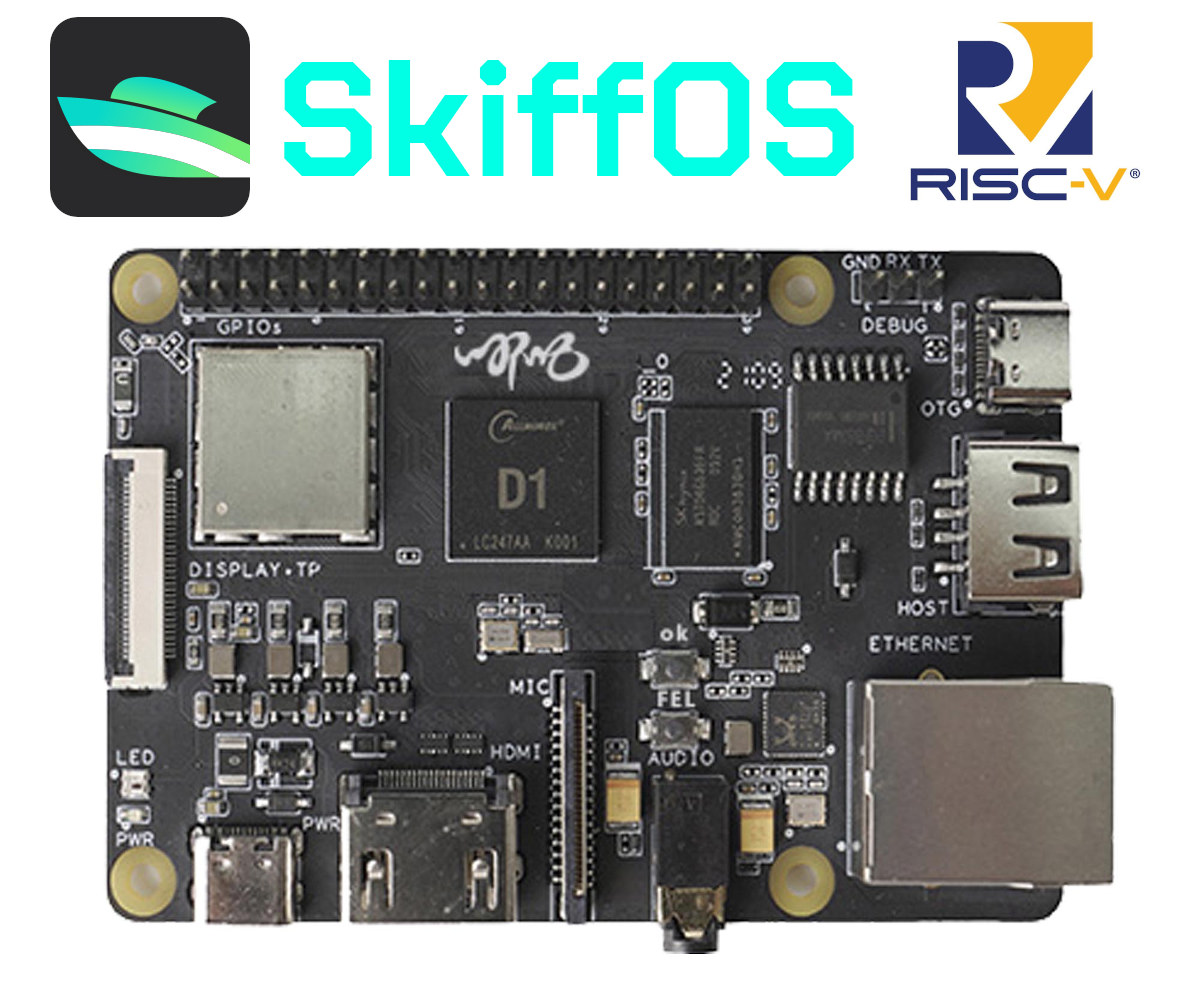Morefine has recently released their S500+ series of mini PC series which features models with either a Zen 2 or Zen 3 AMD mobile processor. Morefine kindly sent one for review and I’ve looked at performance running both Windows and Ubuntu. Morefine S500+ Hardware Overview The S500+ physically consists of a 149 x 145 x 40mm (5.87 x 5.71 x 1.57 inches) square metal case with a plastic top. As an actively cooled mini PC, it is available with either an AMD Zen 2 or Zen 3 mobile processor. The review model came with AMD’s 7 nm Zen 2 Ryzen 7 5700U Lucienne processor which is an eight-core 16-thread 1.8 GHz mobile processor boosting to 4.3 GHz with Radeon Graphics. The front panel has a power button, a light to indicate power, two USB 3.1 ports, and a Type-C USB 3.1 port with Alternate Mode. The rear panel includes a […]
StarFive releases Perf tool for highest performance RISC-V IP Dubhe (Sponsored)
As a StarFive Technology in-house developed RISC-V 64-bit ultra-high-performance core, Dubhe showcases the best performance RISC-V CPU core IP yet. It utilizes the latest RISC-V instruction set which includes RV64GC, bit operation extension (B), vector extension (V) V1.0, and hypervisor extension H (Hypervisor), making it ideal for high-performance computing. To pair with the Dubhe performance core, StarFive is now releasing “StarFive Perf Performance Profiling Tool”. StarFive has made Perf compatible with the hardware performance monitor (HPM) and micro-architecture events at the hardware level. Perf provides a reliable performance verification platform that not only facilitates customers to further discuss the Dubhe technical specifications but also accelerates the implementation of high-performance applications with RISC-V processors. Perf is an open-source and Linux-based performance analyzing tool capable of providing performance monitoring of the hardware events, tracepoints, firmware events, and dynamic probes. With the Perf profiling tool, we can monitor the performance of the predefined […]
QEMU 7.0 released with support for RISC-V KVM, Intel AMX, and more
QEMU (Quick EMUlator) is an open-source emulator used to run OS or programs on various architectures such as Arm, RISC-V, and many others when you don’t own specific hardware, or for quick testing. The developers have released QEMU 7.0 a few days ago with over 2500 commits from 225 developers. New features include support for RISC-V KVM and vector extensions, Intel AMX (Advanced Matrix Extension), improved flexibility for fleecing backups, various new features for Arm, and many more. QEMU 7.0 highlights listed by the developers: ACPI: support for logging guest events via ACPI ERST interface virtiofs: improved security label support block: improved flexibility for fleecing backups, including support for non-qcow2 images ARM: ‘virt’ board support for virtio-mem-pci, specifying guest CPU topology, and enabling PAuth when using KVM/hvf ARM: ‘xlnx-versal-virt’ board support for PMC SLCR and emulating the OSPI flash memory controller ARM: ‘xlnx-zynqmp’ now models the CRF and APU control […]
Ubuntu 22.04 LTS “Jammy Jellyfish” released
Canonical has just released Ubuntu 22.04 LTS “Jammy Jellyfish” right on schedule. The new version of the Linux operating system provides cloud confidential computing, a new real-time kernel for industrial applications, Arm optimization, support for Raspberry Pi SBCs, as well as support for enterprise Active Directory, PCI-DSS, HIPAA, FIPS, and FedRAMP compliance. Confidential Computing aims to improve data protection and privacy in public clouds without requiring any changes to existing application deployments, and Ubuntu 22.04 supports Azure Confidential VMs. Speaking about cloud computing, Canonical also says they optimized Ubuntu 22.04 LTS images for AWS Graviton for greater performance on Arm servers. The new real-time PREEMPT_RT kernel is currently in beta and available for both x86 and Aarch64 architectures. It is designed for telco (5G gateways) as well as other latency-sensitive applications such as industrial automation and robotics. Ubuntu 22.04 LTS is also the first long-term support release with Ubuntu Desktop […]
NVIDIA NVDLA AI accelerator driver submitted to mainline Linux
A large patchset has been submitted to mainline Linux for NVIDIA NVDLA AI accelerator Direct Rendering Manager (DRM) driver, accompanied by an open-source user mode driver. The NVDLA (NVIDIA Deep Learning Accelerator) can be found in recent Jetson modules such as Jetson AGX Xavier and Jetson AGX Orin, and since NVDLA was made open-source hardware in 2017, it can also be integrated into third-party SoCs such as StarFive JH7100 Vision SoC and Allwinner V831 processor. I actually assumed everything was open-source already since we were told that NVDLA was a “complete solution with Verilog and C-model for the chip, Linux drivers, test suites, kernel- and user-mode software, and software development tools all available on Github’s NVDLA account.” and the inference compiler was open-sourced in September 2019. But apparently not, as developer Cai Huoqing submitted a patchset with 23 files changed, 13243 insertions, and the following short description: The NVIDIA Deep […]
Volla Phone 22 runs Ubuntu Touch or a Google-free Android OS (Crowdfunding)
Volla Phone 22 is a 6.3-inch smartphone powered by a MediaTek Helio G85 processor that focuses on privacy and runs either Ubuntu Touch from UBPorts, Volla OS Android fork without Google Play services or apps (YouTube, Gmail, etc…), or others operating through a multi-boot. Hardware-wise, the Volla Phone 22 is a mid-range smartphone with 4GB RAM, 128GB storage, and it also comes with features not found on most recent smartphones including a user-replaceable battery, a 3.5mm audio jack, and a microSD card socket. Volla Phone 22 specifications: SoC – Mediatek Helio G85 octa-core processor with Arm Cortex-A75 cores @ up to 2.0 GHz, Cortex-A55 cores @ up to 1.8 GHz, Arm Mali-G52 MC2 GPU up to 1.0 GHz System Memory – 4GB RAM Storage – 128GB eMMC flash, microSD card socket Display – 6.3-inch Full HD display with 410 ppi pixel density. Audio – 3.5mm jack, built-in microphone and speaker […]
ROC-RK3588S-PC is the first Rockchip RK3588S SBC, supports up to 32GB RAM
Rockchip RK3588S processor, a cost-down version of Rockchip RK3588 SoC with fewer interfaces, has made its way into Firefly ROC-RK3588S-PC SBC (single board computer) about the size of a credit card and equipped with up to 32GB RAM. The compact SBC also comes with up to 128GB eMMC flash, and offers support for NVMe storage, up to four video outputs through HDMI, USB-C and MIPI DSI interfaces, Gigabit Ethernet, USB 3.0, two MIPI CSI camera interfaces, and more. Firefly ROC-RK3588S-PC specifications: SoC – Rockchip RK3588S octa-core processor with 4x Cortex-A76 cores @ up to 2.4 GHz, four Cortex-A55 cores, Arm Mali-G610 MP4 quad-core GPU with OpenGL ES3.2 / OpenCL 2.2 / Vulkan1.1 support, 6 TOPS NPU, and an 8Kp60 H.265/VP9/AVS2 video decoder, 4Kp60 decoder, 8Kp30 H.265/H.264 video encoder System Memory – 4GB, 8GB, 16GB or 32GB LPDDR4/LPDDR4x/LPDDR5 Storage 16GB, 32GB, 64GB, or 128GB eMMC flash M.2 (PCIe 2.0) socket for […]
SkiffOS minimal Linux for embedded containers now supports Sipeed Nezha RISC-V board
SkiffOS minimal Cross-compiled Linux for embedded containers has just added support for Sipeed Nezha RISC-V single board computer, and work on the smaller Sipeed Lichee RV board has started. Wait… What is SkiffOS? I’ve never heard about it… That’s how the abstract from the white paper describes it: Embedded Linux processors are increasingly used for real-time computing tasks such as robotics and Internet of Things (IoT). These applications require robust and reproducible behavior from the host OS, commonly achieved through immutable firmware stored in read-only memory. SkiffOS addresses these requirements with a minimal cross-compiled GNU/Linux system optimized for hosting containerized distributions and applications, and a configuration layering system for the Buildroot embedded cross-compiler tool which automatically re-targets system configurations to any platform or device. This approach cleanly separates the hardware support from the applications. The host system and containers are independently upgraded and backed-up over-the-air (OTA). In other words, that’s […]


